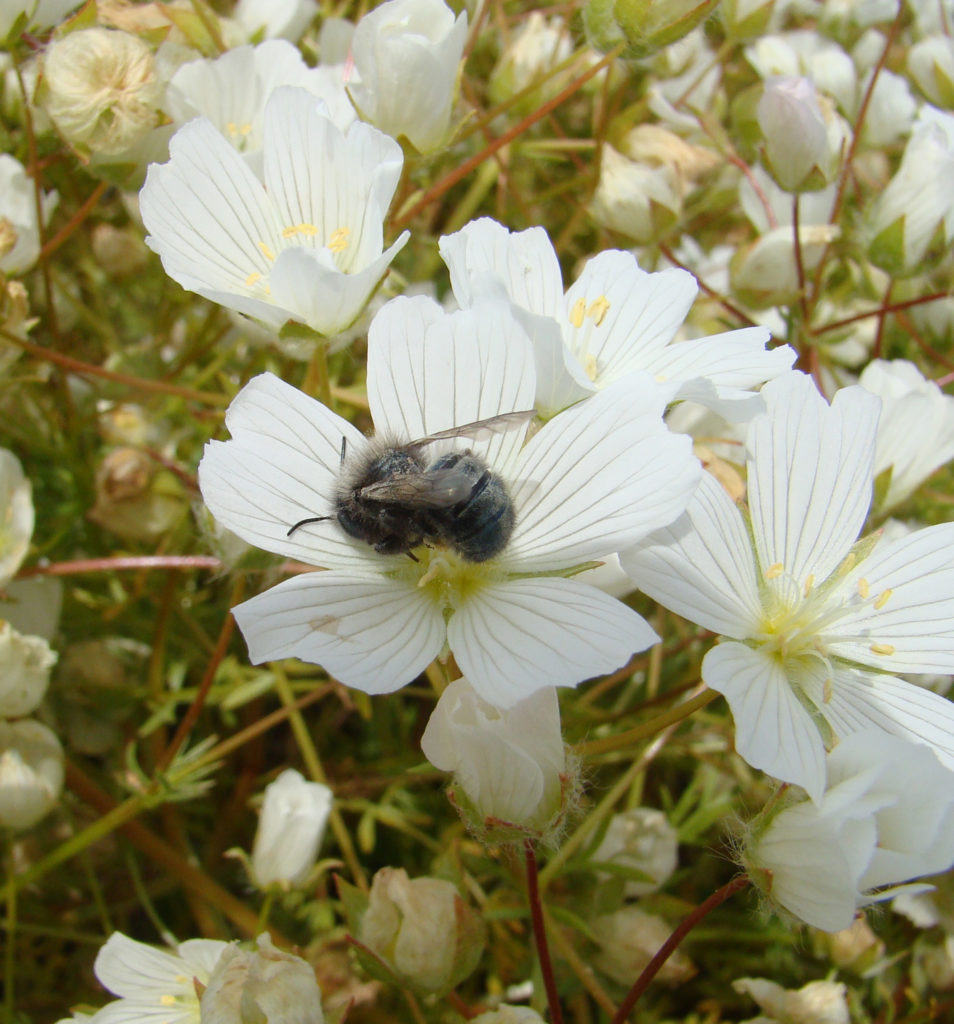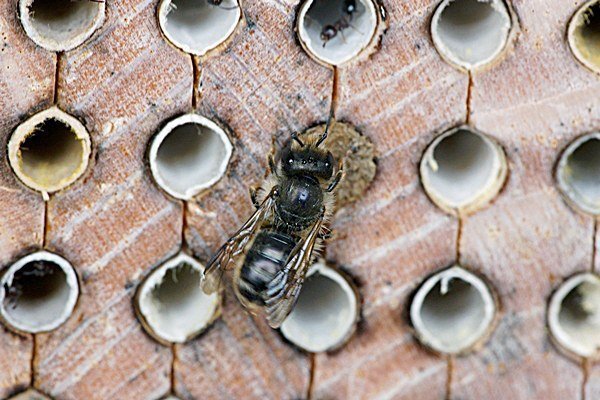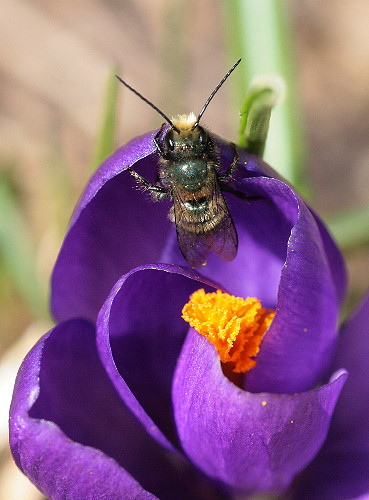
You’ve probably heard the buzz about honeybees and how important they are to agriculture, but did you know that native bees such as mason bees are even better and more efficient pollinators of native crops? In fact, the species Osmia lignaria (pictured above) has been named the blue orchard bee for its recognized usefulness in pollinating fruit trees across North America. The blue orchard bee co-exists with the similar Japanese orchard bee Osmia cornifrons, which was introduced to the United States in the 90’s but is now well-established in the wild. Though more than 500 related species of bees exist in the Mid-Atlantic region, the blue orchard bee is one of the few native pollinators that is managed for agriculture in Pennsylvania.
Part of why mason bees are so prized for their pollinating power is that they emerge in early spring, when it’s still relatively cool and not many other pollinators are out. The life cycle of the blue orchard bee has evolved to coincide with the blossoming of fruit trees such as apricots, plums, pears, apples, and cherries- in fact they are generally only active for a few weeks around bloom time in March and April! Some other much-loved plants of this species include currants, gooseberries, elderberry, and huckleberry. Mason bees are special because they carry pollen on their abdomen instead of their legs, so when they land on individual flowers a lot of pollen is directly transferred from other blossoms. Another bonus as far as urban orchards are concerned, mason bees do not sting!

Nesting patterns
Unlike honeybees, which are highly social and live in hives, mason bees are solitary, meaning that each female builds and takes care of her own nest (no queen here!). That being said, mason bees are often gregarious and will nest near other mason bees. Mason bees naturally nest in the hollow reeds of plant stems or in similar crevices that appear in their environment, such as cracks in firewood, slash removed from orchards, and cavities excavated by boring beetles in deadwood. After laying a single egg in each cell and provisioning it with a pea-sized mass of pollen for food, the female mason bee constructs a mud wall to close off the cell – just like a mason might build a house using mud bricks! Within a week, the eggs hatch, and the bee larvae spend the summer metamorphosizing into pupae and later onto adults, which then stay nice and cozy inside their home for the entire winter… until next spring, when it’s time to emerge and start the process all over again.
Mason bees tend to pollinate and nest not too far from where they emerge, so it’s relatively straightforward to introduce new populations to your orchard in the winter by purchasing tubes of cocoons containing adult bees from another local orchard that is already managing them. Keep the cocoons refrigerated at least until late March to prevent premature emergence during midwinter thaws, but release them no later than mid-May to reduce mortality. Purchasing new bees may be unnecessary, though, since wild mason bees in the area will be more than happy to accommodate artificial nesting material that you prepare for them.
Managing mason bees
Artificial nests can be made from wood blocks drilled with a series of holes, cardboard tubes with one end plugged, or sections of reed and bamboo with a stem node intact on one end. Ideally, each nest should have a 6 to 8-inch long internal tunnel that is about 5/16 of an inch in diameter. Mason bees generally lay female eggs first, since they will be the most insulated, with male bees on the outside, so if the tunnels are too shallow, you may not end up with enough females to do the hard work the following year! These types of nests can be bundled together and placed horizontally throughout the orchard several feet above ground level under some sort of rainproof shelter. Some good locations include the sides of buildings, adjacent to cliff faces, or open sheds or garages, and a southward orientation encourages exposure to sunlight (but not too much). Remember to place your nests close to a steady source of mud! This can be as simple as an excavated hole with a dripping water hose or bucket.
Nests must be managed carefully in order to prevent the spread of parasites and diseases. Mason bee nests are often subject to predation by wasps, which can drill through wood to lay their own eggs on developing bees. Once the wasp eggs hatch, the larva eat the mason bee alive! One way to reduce wasp parasitism is to remove sealed nests from the orchard in the summer and move them to a dry, unheated and non-air-conditioned building such as a barn. Alternatively, the cocoons can be refrigerated for the winter.
Mites can also pose a serious problem to mason bee nests. Mite-infested cells are recognizable by the fluffy remains of shed mite skins and consumed pollen debris (rather than a compact ball of yellow pollen). Infested cells should be removed immediately to prevent further infestation, and healthy cocoons can be removed from the nests to be stored in refrigeration. Any nests intended for reuse the following year should be thoroughly cleaned and sanitized, or else the mason bees should be provided with new nesting materials in the spring.
Finally, as with many other beneficial insects, mason bees are very sensitive to pesticide use. Spraying should definitely be avoided during nesting season. Moving nests and nesting materials while the females are still constructing them can be very disorienting and will most likely result in abandonment of the nests.

Attracting solitary bees
In addition to providing valuable pollination services for fruit trees, blue orchard mason bees and other solitary bee species help diversify your orchard or food forest, leading to a healthier ecosystem, healthier humans, and a healthier planet. Providing them with nesting materials may attract wild bees in your area, or you could source them from another local orchard. Be on the lookout for these solitary insects in the early spring, and consider providing supplemental wildflowers to your garden, which will be appreciated by managed and native pollinators alike. Bees tend to be drawn the most to blue, purple, white, and yellow flowers.
Some specific native plants that bees love include…
- Aster
- Bee balm
- Black willow
- Blackberry
- Blue wild indigo
- Blueberry
- Coneflower
- Elderberry
- Goldenrod
- Trumpet vine
- Lily
- Lobelia
- Maple
- Milkweed
- Phlox
- Red buckeye
- Rose
- Sassafras
- Serviceberry
- Lupine
- Violet
- Turtlehead
Additional (re)sources:
Penn State Extension
Oregon State Extension
USDA Forest Service
Managing Alternative Pollinators: A Handbook for Beekeepers, Growers, and Conservationists
Phigblog: Making Mason Bee Homes
Where to purchase mason bees and supplies:
BeeDiverse
Pollinator Paradise
Back Yard Fruit Growers
This blog article written by 2019 POP Intern Piotr Wojcik.
SUPPORT US! If you found this entry useful, informative, or inspiring, please consider a donation of any size to help POP in planting and supporting community orchards in Philadelphia: phillyorchards.org/donate.